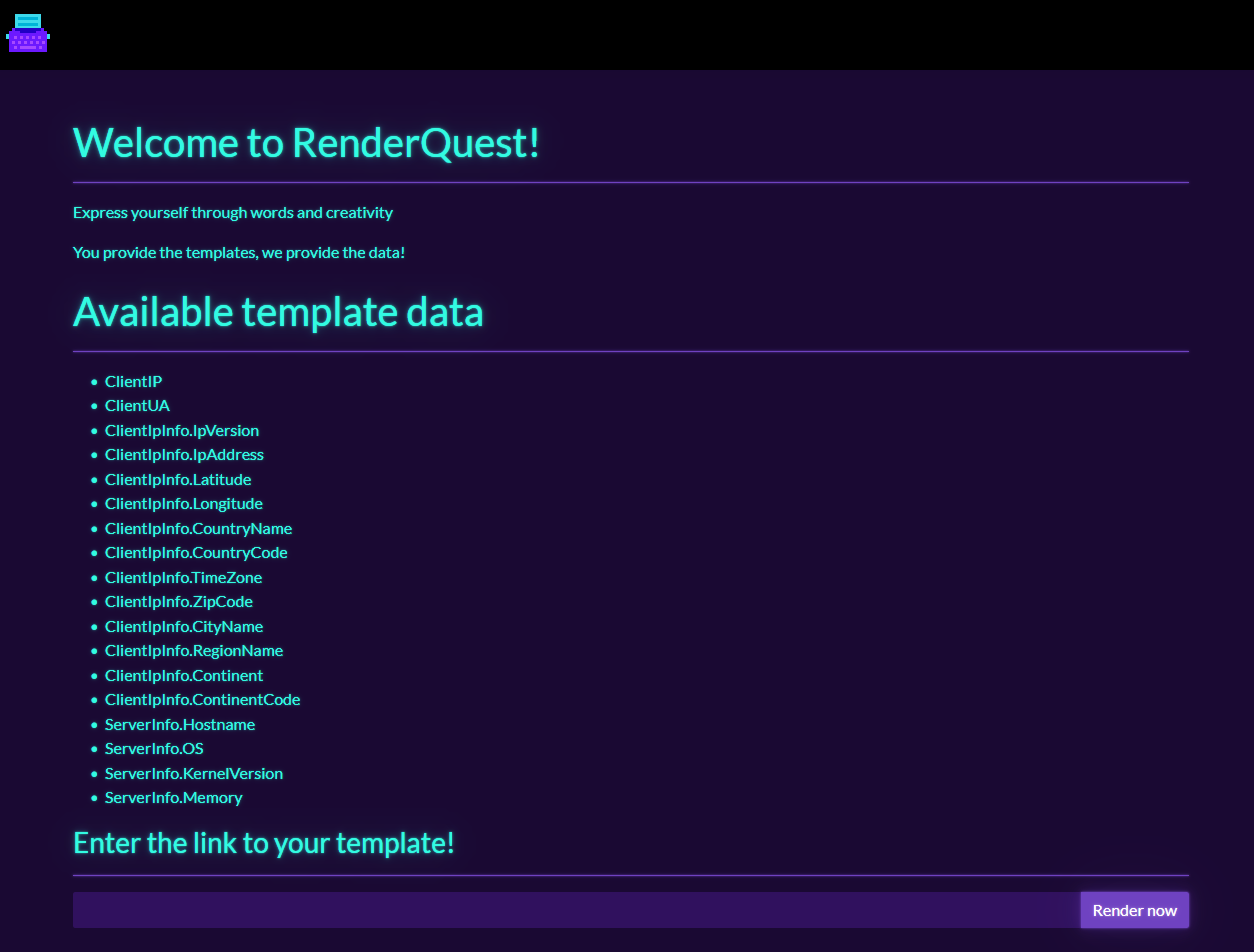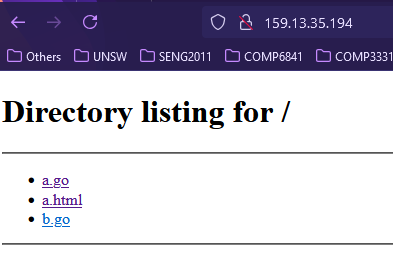By: leanthedev
3 hours
This challenge was quite a fun one to solve, and with experience in Golang, I figured it shouldn't be too difficult to figure out. Funnily enough, this particular challenge had a lot of red herrings, which made it a bit more difficult to pin-point what the actual vulnerability was.

The application
Reconnaissance
From previous challenges, I started taking a bit more time to note down the things that I found interesting, before I went in to start planning an approach.

Dockerfile
Taking a look inside the Dockerfile - once again we have a random flag file name, we will most likely have to get some form of RCE to be able to figure out the name of the flag.
There is a static folder - but this doesn't seem to have much to it - just looks like the CSS for a simple bootstrap theme, and its corresponding JS scripts. There is also a custom JS script file, which contains some basic cookie setting and some script to run a function to get the template file. There's nothing particularly interesting other than the fact that we can put in any link for the template file, seemingly.
window.onload = async () => { document.getElementById("templateButton").addEventListener("click", () => { window.location.href = "/render?use_remote=true&page=" + document.getElementById("templateLink").value; });
if (isCookieSet("user_ip")) { return; }
const response = await fetch("https://freeipapi.com/api/json/");
if (response.status === 200) { const ipData = await response.json();
const trueClientIP = ipData.ipAddress;
document.cookie = `user_ip=${trueClientIP}; path=/`; } else { console.error("Failed to fetch IP data"); }}Now, we get to the main meat of the program: the main.go file. There are a few interesting things to note here, let's explore them - a lot of which were unfortunately red herrings, or at least was not the immediate vulnerability.
Red Herring Central
The first thing I saw was the exposure and serving of the /static folder on the server:
mux := http.NewServeMux()
mux.HandleFunc("/", getIndex)mux.HandleFunc("/render", getTpl)mux.Handle("/static/", http.StripPrefix("/static/", http.FileServer(http.Dir("static")))) 
Static folder exposed
I thought that this could potentially be a path traversal vulnerability - but after testing it out using some tricks from previous challenges and online resources, I found that it probably wasn't possible (or at least easily). It would appear that the http.StripPrefix function was sanitising the input, with the mux library safely handling the serving of the static files.
From previous reflections and challenges, I learnt to not dwell too long on a specific idea if it doesn't work out, so I move on to the next potential vulnerability, keeping this in the back of my mind.
The next thing I noticed was the possibility of reading files locally:
if remote == "true" { tmplFile, err = readRemoteFile(page)
if err != nil { http.Error(w, "Internal Server Error", http.StatusInternalServerError) return } } else { tmplFile, err = readFile(TEMPLATE_DIR+"/"+page, "./")
if err != nil { http.Error(w, "Internal Server Error", http.StatusInternalServerError) return } } In particular, the else block (when remote is not true) seemingly allows the possibility of reading files outside of the TEMPLATE_DIR directory. However, after briefly testing this out, I found that the readFile function was sanitising the input, and only allowing the reading of files within the TEMPLATE_DIR directory.
func readFile(filepath string, basePath string) (string, error) { if !isSubdirectory(basePath, filepath) { fmt.Println("Invalid filepath") return "", fmt.Errorf("Invalid filepath") }
The isSubdirectory function was checking to see if the filepath was a subdirectory of the base path, and if not, it would return an error. It also utilises relative pathing to break down any path to be broken down and simplified. For example if the path was../../../../../etc/passwd, it would be simplified to/etc/passwd. It probably would be possible to bypass this filter in some way - but I didn't spend too much time on it.
Nothing much to see here, it seems - another slight red herring. Moving on.
The next thing I noticed was the FetchServerInfo function in the main.go file:
func (p RequestData) FetchServerInfo(command string) string { out, err := exec.Command("sh", "-c", command).Output()
if err != nil { return "" } return string(out)} A function that takes in a command as an argument and directly runs it? Seems suspicious. Looking through the references to this particular function, I found only 4 references:
reqData.ServerInfo.Hostname = reqData.FetchServerInfo("hostname")reqData.ServerInfo.OS = reqData.FetchServerInfo("cat /etc/os-release | grep PRETTY_NAME | cut -d '"' -f 2")reqData.ServerInfo.KernelVersion = reqData.FetchServerInfo("uname -r")reqData.ServerInfo.Memory = reqData.FetchServerInfo("free -h | awk '/^Mem/{print $2}'") These all used hard coded commands - not user input. Might not be directly possible through this method, so at the moment, going to move along.
One thing to pay attention to though, is the fact that the function for running commands is defined in the RequestData struct as a receiver method - similar to methods associated with classes. Not sure why this was written as such, given that the struct data is never even used, but it was something to keep in mind.
The Vulnerability
Then it hit me - the whole entire purpose of this website allowed one to render any potential given URL with a template. This was a classic Server-Side Template Injection (SSTI) vulnerability. While I had heard about SSTI vulnerabilities before, I had never actually encountered one in the wild. This was a good opportunity to learn more about it.
Using our good friend HackTricks , I found that the Go template engine was quite powerful, and could be used to execute arbitrary code. How? Well - the Go template engine essentially allows for the substitution of certain Go code within the template for values.
I have a free Oracle Cloud instance that I use for testing, so I decided to use that to host a simple file hosting service using the default Python HTTP server. (Why are there no basic file hosting services without fancy bells and whistles?)

File hosting service
In b.go, I placed in some basic XSS code to test the templating and see if my SSTI was working:
{{"<script>alert(1)</script>"}}

Whoops - I realised that the template engine we were using was html/template, which is more complicated and safer than text/template. No worries, HackTricks to the rescue with a different payload:
{{define "T1"}}alert(1){{end}} {{template "T1"}}

Huh - nothing. But then I realised - why am I performing an XSS attack? I have a Go templating engine, I could probably execute Go code rather than JavaScript code. Unnecessary side track on my part.
Testing a different SSTI payload, I used this:
{{ . }}

Ooh now we're talking. This particular payload allowed me to see the underlying data structure in the context that we were in, and proved that our Go SSTI was working.
Further reading on HackTricks showed me that I could access other methods within Go templates:

Source: hacktricks.com
Remember the FetchServerInfo function that I mentioned earlier? Because it was defined in the RequestData struct and we were working within the context of the struct, I was able to call it directly in the template:
{{.FetchServerInfo "ls ../flag*.txt | xargs cat"}} 
And there we have it - the flag!
Reflection and Learnings
This challenge was a good reminder to me that complacency is quite a problem - my initial thoughts thinking that the challenge would be easy due to the familiarity of the language was a mistake. The challenge - while not particularly difficult - had a lot of red herrings that complicated the process of identifying the core vulnerability.
This underlined a lesson - familiarity with a language is good, but doesn't translate to ease, especially in a security context. Luckily, from previous challenges, I had already learnt to not dwell too long on a particular idea if I wasn't getting too far with it - which helped me to not get too bogged down in the red herrings.
A key change in the way I approached this challenge I think was the fact that I took a bit more time to note down the things that I found interesting, before I went in to start planning an approach - you may notice a specific reconnaissance section in the more recent writeups. This helped me scope out the challenge, get a feel for what I was working with, before jumping in.
Not only did this prove very useful in not getting too far down any particular rabbit holes, it also helped me to keep track of what I had already tried, and what I hadn't. In addition to this, keeping track of some of the things I noticed (e.g. the FetchServerInfo function) helped me to quickly make the connection once I found the right vulnerability, despite it first seeming to be a red herring.
I do also realise the importance of not diving in too quickly in real web penetration testing - starting immediately with no plan could lead to wasted time, and giving time for the target to potentially detect you.
This challenge was my first encounter with Server-Side Template Injection (SSTI), and it was quite an interesting experience. When used correctly, SSTI is a powerful tool for generating dynamic content, but when used incorrectly, it can lead to a lot of pain.
This once again underlines the importance of input validation and sanitisation - the vulnerability was present because the application allowed for the rendering of any template file given by the user.
Of course, we hear all the time that we should keep our tech stack up to date to avoid accumulation of tech debt leading to vulnerabilities.
I certainly hope and think that I'm not the only one who thought that this translated to modern languages being fully secure. This challenge was a good reminder that even modern languages can have vulnerabilities, and that it's important to keep up to date with the latest security practices.
Even with a modern language, the biggest vulnerability will always boil down to the person writing the code.
Last Writeup
Pop Restaurant
Next Writeup
Insomnia